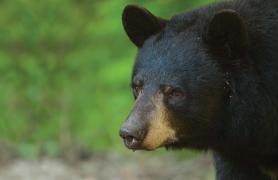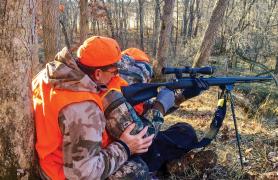At greatmissouribirdingtrail.com, find an easy-to-use interactive map with the state’s best places to bird.
Most serious bird watchers remember the exact moment they fell in love with birds. One of Lisa Berger’s earliest memories is crouching inside a hedge to hear white-eyed vireos twittering around her.
“I would imitate their songs,” she recalled, noting she was 6 years old when she started toting her parents’ binoculars so she could list and draw the birds she was seeing. Today, she frequently leads field trips for the Greater Ozarks Audubon Society.
Berger compared the hobby to a “grown-up Easter egg hunt.”
“When you see a bird for the first time, and you get a good look at it in good light, it’s spellbinding,” she said. “It’s search and serendipity. The birds are out there — you just have to cross their path. But it’s not guaranteed, and that’s what makes it exciting.” Berger is one of 47 million bird watchers nationwide and one of 1.1 million birding Missourians, according to the 2011 National Survey of Fishing, Hunting, and Wildlife-Associated Recreation. Whether you’re a beginner birder or a seasoned veteran, knowing where to go is a must.
A partnership between the Missouri Bird Conservation Foundation and MDC seeks to provide just that through the creation of the Great Missouri Birding Trail.
What is a Birding Trail?
A birding trail is not a physical walking trail but a list or map of the best places to bird-watch in an area. Over 40 other states have birding trails that highlight prime bird-watching and wildlife-viewing locations.
The Great Missouri Birding Trail is online at greatmissouribirdingtrail. com. It provides an easy-to-use interactive map with the state’s best places to bird. The site also provides information for beginners on basic gear and how to identify and help birds on their property. The trail is online and mobile-friendly for access anytime, anywhere.
“The Great Missouri Birding Trail encourages everyone to discover the excitement of birding in Missouri. Whether you’re a newbie or oldschool, the trail offers something for everyone,” said Sarah Kendrick, MDC state ornithologist.
The trail is divided into six regions: St. Louis, Central, Kansas City, Southwest, Southeast, and Northeast. The St. Louis and Kansas City regions also have metro trails, which feature places to bird close to the cities’ centers, most of which are accessible by public transit.
Each trail site on the map has a description highlighting the area’shabitat, probable bird sightings, driving directions, and a link to the area’s eBird page for reports of recent sightings and birding history.
How was the Trail Started?
Mike Doyen of Rolla, president of Missouri Bird Conservation Foundation, founded the trail while working as the CEO of an executive search firm. He needed a hobby, so he turned to birding. After joining the local Audubon Society and becoming very active, Mike was driven to find new ways to engage more people in bird watching and native habitat management.
“I worked to develop a conservation ethic in my community through a fundraising campaign and purchase of a local 70-acre nature center. My next challenge was to reach a broader audience,” he said. “Out of this came the Great Missouri Birding Trail.”
Knowing that birders need fuel to travel and drive by filling stations daily, Doyen approached Wallis Companies, owner of the Missouri based On the Run convenience store franchise and big supporters of conservation. The Wallis family supported Doyen’s idea and provided the funds to complete the first portion of the trail in the St. Louis region.
At about the same time, MDC’s Wildlife Division was contemplating the same kind of trail project. “I was really interested in starting a Missouri birding trail to spark more interest in bird watching,” said Kendrick. “So I reached out to partner groups and agencies that may have a shared interest and soon discovered that Mike had already started one.”
MDC approached Doyen, and by May 2015, a cooperative agreement was signed. Since that time, the trail has grown by leaps and bounds.
How Were Trail Sites Chosen?
More than 190 sites were identified by experienced bird watchers affiliated with the Audubon Society of Missouri (ASM) and MDC. The trail could not have been completed without the assistance of ASM birders, both Kendrick and Doyen said.
“Local birders live near the trail sites and bird them with some frequency in all seasons,” he said. “This partnership was instrumental as we searched for the best sites across the state.”
The locations were picked based on one overriding criterion — each represents high-quality native Missouri habitat. “If the habitat is right, the birds will be there,” Doyen said. MDC staff — working with Doyen and other birders — visited all of the field locations, wrote the site descriptions, and edited the website. “It’s been a great partnership,” Kendrick said. “We’re both interested in getting people outdoors and exposing them to the beauty and diversity of birds and their habitats.” Doyen agreed.
“The Missouri Department of Conservation is an excellent partner,” Doyen said. “We have the same goals and together we are building something special for Missouri birders while helping to improve bird habitat.”
Habitat is Key
The site also introduces new birders to Missouri’s diverse habitats, which more than 350 species of birds use annually, whether year-round or during migration.
Nate Muenks, MDC’s habitat management coordinator, said it’s important that the conservation community keep an open dialogue and educate Missouri citizens about the vital role that habitat plays in species’ survival.
While some species are generalists that may thrive in a number of different habitats, others are specialists that rely upon particular habitat characteristics to survive, he said.
“Grassland birds, for example, are the most rapidly declining group of birds in North America,” he explained. “If we continue to lose our native grasslands, we will continue to see declines in grassland wildlife. This includes birds like greater prairie- chickens, Henslow’s sparrows, and eastern meadowlarks.”
In addition to habitats, the site also promotes Missouri’s public lands and encourages visitors to explore those sites.
“The site is a wealth of information,” Doyen said. “And we are continuously
updating and adding new material.”
Native = Bird-Friendly
When Doyen started the trail, he wanted it to be more than a list of the best places to view birds in Missouri. It also had to function as an educational tool for bird conservation, including the importance of native plants and habitat.
Before people decide to plant native species, Doyen said it helps if they first harbor an appreciation for native habitats.
“MDC has done more than anyone to save precious bird habitat across Missouri. Now it’s our turn to join the fight. Imagine if 15 to 20 years from now, hundreds of thousands of privately owned backyards and back 40s are planted in native grasses, wildflowers, and trees. Plant native, grow native, and bring native Missouri back to your property,” Doyen said.
It’s an idea Kendrick confirmed. “We are so blessed in Missouri. Our state boasts some of the healthiest and most diverse native habitat in the Midwest, from prairie to wetland
to Ozark forest. Migratory and resident birds really depend on these habitats to be maintained and kept top-notch.”
Doyen believes most Missourians simply aren’t aware of the implications nonnative species have for wildlife. If a plant is not native, it can be of minimal use to native wildlife. Healthy bird populations can’t be sustained without healthy habitats, he said.
“With time and resources, I’m hopeful more people will begin to take bird habitat seriously. We havea lot of converts to the Grow Native!movement,” he said. “Bird conservation starts at home.”
Nature’s Gateway Hobby
River Bluffs Audubon Society member Rick Thom uses other states’ birding trails to find high-quality natural communities when he travels out of state. He sees the same benefits in the Great Missouri Birding
Trail.
“I think it’s going to be a useful tool for both Missouri residents and visitors,” Thom said.
He added people who are intrigued by birds often are curious about other topics, such as history, geology, flora, and nearby attractions.
Each trail stop description includes a short list of cultural information about each birding area, Thom said. “That cross-appreciation for an area’s other features is a good thing,” he said, explaining while one family member may be an avid birder, another may be a history buff.
Kendrick hopes bird-watching will serve as a gateway for Missouri residents and visitors to explore other aspects of the outdoors, develop a greater appreciation for nature, and spend quality time with friends and family.
“Birds are awesome, and they’re so accessible. They can be found everywhere from urbanized settings to remote wildernesses, and no two birding trips are ever the same,” she said. “The whole point of the trail is to encourage people, regardless of experience, to enjoy birds. It’s never too early to start bird watching, and it’s never too late to learn something new — so what’s stopping you?”
Celebrate the Great Missouri Birding Trail at Regional Launch Events
You’re invited to help celebrate the completion of the Great Missouri Birding Trail. Seven regional launch events will be held to officially open the trail and celebrate its completion. A brief opening ceremony will be held, followed by short guided birding walks on each area. The first 25 attendees at each event will receive a Great Missouri Birding Trail tote bag or water bottle. Great Missouri Birding Trail launch events will be held at the following locations from 9 a.m. to noon:
- May 11 - Springfield Springfield Conservation Nature Center
- May 12 - Rolla Audubon Trails Nature Center
- May 17 - Kansas City Burr Oak Woods Conservation Nature Center
- May 18 - St. Louis Powder Valley Conservation Nature Center
- May 19 - Columbia Eagle Bluffs Conservation Area
- May 24 - Kirksville MDC Northeast Regional Office
- May 26 - Cape Girardeau Cape Girardeau Conservation Nature Center
Birds in Missouri
Check out Birds in Missouri, available through the MDC Nature Shop at mdcnatureshop.com. This beautiful, full-color book features 354 illustrated species, including resident and migratory birds. It also includes range maps and seasonal abundance graphs. Seventeen two-page habitat scenes also portray Missouri’s diverse natural and urban habitats. With this book and a pair of binoculars, you are ready to hit the trail.
































Also In This Issue


And More...
This Issue's Staff
Art Director - Cliff White
Associate Editor - Bonnie Chasteen
Staff Writer - Heather Feeler
Staff Writer - Kristie Hilgedick
Staff Writer - Joe Jerek
Photographer - Noppadol Paothong
Photographer - David Stonner
Designer - Les Fortenberry
Designer - Marci Porter
Designer - Stephanie Thurber
Circulation - Laura Scheuler






















